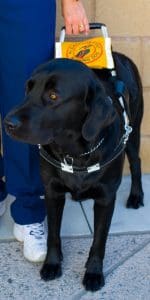by Julie Garland
According to a 2015 report released by the Centers for Disease Control and Prevention, one in five Americans is disabled. Although there are no data to quantify the number of disabled individuals who rely on service animals, an increase in the use of service animals is now evident. The increased presence of service animals, emotional support animals, and therapy animals has led owners of businesses, universities, hospitals, and multifamily housing buildings to ask a variety of questions, the most pressing of which is “is there a legal basis for the use of these animals, and how does it apply to my business or institution?” Responses to these questions fall into a variety of categories, which we will review individually below.
SERVICE ANIMALS
Service animals are highly trained pieces of medical equipment. An animal is task trained to assist its owner/handler in mitigating his or her disability. An owner/handler and service animal are commonly called a “team.” The Americans with Disabilities Act (ADA) recognizes dogs and miniature horses as service animals. Dogs are recognized under both Title II (state and local government services) and Title III (public accommodations and commercial facilities); miniature horses are recognized under a separate provision. Common tasks for service animals may include but are not limited to: guiding the blind or those with a sensory processing disorder; alerting the deaf; balance work (providing physical support while a handler is moving); and providing deep pressure to calm an individual with post-traumatic stress disorder (PTSD) or leading him or her out of a building during an anxiety attack.
WHAT CAN I ASK A PERSON WHO HAS A SERVICE ANIMAL?
When a property owner or manager encounters a person with a service animal, permissible questions are limited to:
(1) “is the dog a service animal required because of a disability?
(2) what work or task has the dog or service animal been trained to perform?”[1]
It is against the law to ask for documentation, either paperwork or demonstration of tasks or to further inquire about a handler’s disability.
Keep in mind that there is no legal certification or breed specification to qualify a dog as a service animal.
Service animals are not required to wear a vest, patch, or tag alerting the public to their status as service animals. Most people opt to have their animals wear a vest or patch to help curb interaction with the public.
WHERE ARE THEY ALLOWED?
Under the ADA, service animals are permitted in all public areas of a facility, including areas where pets would not be permitted such as eating establishments, and medical facilities. Fear of dogs or other patrons’ allergies in no way limit a handler and service animal from accessing a public area.
Miniature horses are the exception to this rule. The ADA lists four factors that may preclude a service horse from entering a public area. They are:
- “Whether the miniature horse is housebroken;
- Whether the miniature horse is under the owner’s control;
- Whether the facility can accommodate the miniature horse’s type, size, and weight; and
- Whether the miniature horse’s presence will not compromise legitimate safety requirements necessary for safe operation of the facility.”[2]
In addition to allowing people and their service animals access to public spaces, business and building owners must not isolate the owner/service animal team from other users of a facility.
WHEN IS IT APPROPRIATE TO ASK A TEAM TO LEAVE?
The two instances in which it is appropriate to ask a person and their service animal to vacate the premises are:
- “The dog is out of control and the handler does not take effective action to control it; and
- The dog is not housebroken.”[3]
HOUSING
According to a 2013 U.S. Department of Justice memo, “housing providers must meet their obligations under both the reasonable accommodation standard of the FHAct/Section 504 and the service animal provisions of the ADA.”[4] This means that housing providers may not refuse housing to an individual with a service animal.
EMOTIONAL SUPPORT ANIMALS (ESAs)
Emotional Support Animals (ESAs) are animals that provide comfort and emotional support to individuals with a verifiable mental or psychiatric condition; they are not task trained. ESAs may be of any species, though they are often dogs, cats, or small animals such as rabbits. Under the ADA, ESAs are not considered service animals; they are not permitted to accompany their disabled owners into areas of public facilities that are not designated as areas in which pets are permitted. Federal regulations do allow ESAs to live in public and private housing with their disabled owner.[5] Under the Fair Housing Act, ESAs are considered a “reasonable accommodation.” If a tenant or a prospective tenant can document that an animal provides support or alleviates symptoms of his or her mental or psychiatric condition, a property manager must permit that animal’s residence as a “reasonable accommodation.” The “reasonable accommodation” clause also applies to universities and to multifamily housing.
THERAPY ANIMALS
Therapy animals are typically pets, and are usually dogs that are owned and handled by non-disabled individuals. Therapy animals are neither service animals nor emotional support animals. These dogs have been certified as a result of testing conducted by one of the national therapy dog organizations and are usually evaluated for therapy-required behaviors that result from basic training and social temperament. The dogs’ owners pay a membership fee that “buys” a certificate denoting that the animal has successfully completed testing, owner/dog liability insurance for when a dog is on a therapy site, updates, and newsletters. Certifying organizations’ tests evaluate a dog’s comfort with strangers, children, mobility aids, and strange movements and noises. Therapy dogs are most frequently seen at nursing homes and in libraries providing therapy support to disabled residents or to helping children improve reading skills through periodic visits, respectively. Tail Wagging Tutors is one such example, as is the Reading Education Assistance Dogs program. These animals do not receive protection under the ADA or the FHA and are not permitted to accompany their owner or handler into public areas or live in housing not designated as pets allowed.
IN CLOSING
Recognizing each class of animal correctly and treating owner/animal teams appropriately as specified under the ADA and FHAct/Section 504 continues to present challenges in the U.S.
It is our hope that this overview of human/animal partnerships that includes service animals, emotional support animals, and therapy animals helps to clarify these animals’ roles and the ways in which their use is protected or prohibited by law. The links below may be of interest to those who seek more in-depth information about any of the topics above.
Service Animal Links:
Public Perceptions of Service Dogs, Emotional Support Dogs, and Therapy Dogs
Frequently Asked Questions about Service Animals and the ADA
Service Animals, Northwest ADA Center
Service Animals and Emotional Support Animals, ADA National Network
Emotional Support Animal Links:
Disability Rights of North Carolina: Animals and the Fair Housing Act
Massachusetts Office of Disability Blog: Assistance Animals: Rights Under Fair Housing Laws
Reasonable Accommodations under the Fair Housing Act
National organizations that certify dogs as therapy dogs include:
Pet Partners (f/k/a Delta Society)
[1] “Frequently Asked Questions about Service Animals and the ADA.” Frequently Asked Questions about Service Animals and the ADA, U.S. Department of Justice, 12 July 2011, https://www.ada.gov/service_animals_2010.htm.
[2] “Frequently Asked Questions about Service Animals and the ADA.” 2011.
[3] Ibid.
[4] “Subject: Service Animals and Assistance Animals for People with Disabilities in Housing and HUD-funded programs.” U.S. Department of Housing and Urban Development. April 25, 2013. https://www.hud.gov/sites/documents/SERVANIMALS_NTCFHEO2013-01.PDF.
[5] Regina Schoenfeld-Tacher et al., “Public Perceptions of Service Dogs, Emotional Support Dogs, and Therapy Dogs,” International Journal of Environmental Research and Public Health, June 2017, accessed October 21, 2017, https://www.ncbi.nlm.nih.gov/pmc/articles/PMC5486328/.

